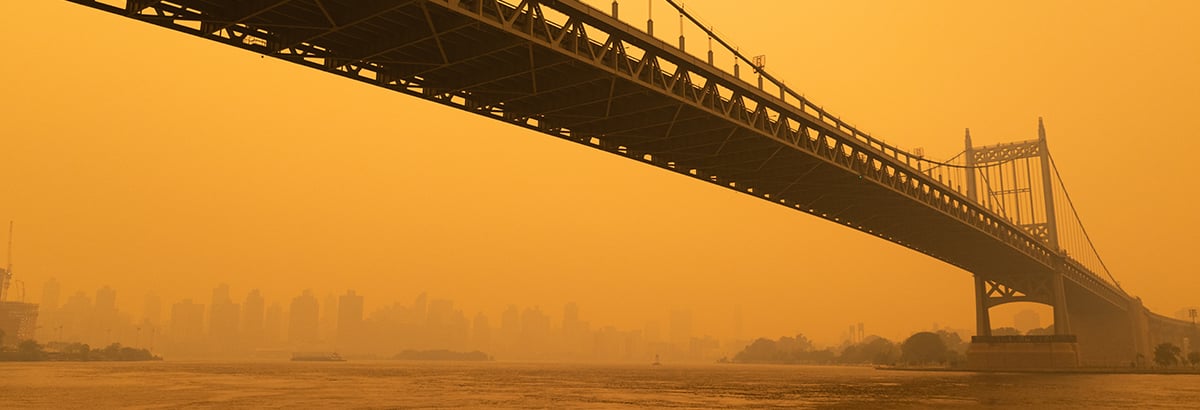Wildfire Aftermath: How to Improve Air Quality as the Dust Settles

As major wildfires cause record-breaking air pollution, the dust is literally settling across several heavily populated states1.
The smoke from wildfires can be hazardous to human health, causing the following symptoms, according to the CDC2:
- Coughing
- Trouble breathing normally
- Stinging eyes
- A scratchy throat
- Runny nose
- Irritated sinuses
- Wheezing and shortness of breath
- Chest pain
- Headaches
- An asthma attack
- Tiredness
- Fast heartbeat
Public health officials may advise people in the affected areas to stay inside and to keep doors and windows closed. However, you should be aware that some of the smoke from outdoors can enter your facility3 and make it unhealthy to breathe indoor air, too. For facility managers, it’s important to ensure that the air quality is as clean as possible and keep pollutants to a minimum.
There are several critical steps to reduce exposure to smoke particles and improve indoor air quality at your facility:
Matting
- 80% of incoming dirt, sand, and debris from outside can be captured right at the door of a building or residence.
- Use a proper entrance matting system to prevent people from tracking smoke, ash, and other pollutants on their shoes.
- Clean matting regularly with a vacuum cleaner with a HEPA filter.
Air Purifiers
- Install free-standing purifiers like AeraMax Professional air purifiers4 in office areas, conference rooms, and common areas. These commercial-grade air purifiers use four-stage air filtration with True HEPA filters to remove up to 99.97 percent of airborne contaminants effectively and efficiently.
- It’s important to note that air filters and cleaners alone cannot remove 100% of indoor air pollutants. Also, if you’re considering using an air cleaner, make sure that it can remove the type and number of pollutants you need. Regardless, your HVAC system will undoubtedly have an air filter that you can upgrade and change periodically. The EPA recommends using a MERV 13 or higher rated filter if your system can accommodate it.

HEPA Filtered Vacuums
- Use vacuums equipped with HEPA filters, which are required to remove at least 99.97% of air particles5.
- Just don’t forget that the filters need replacing every so often to remain effective. After all, if your filter is dirty, it’s not able to remove any allergens caused by dust from your floors.
Cleaning Equipment
- Use a no-touch cleaning caddy like KleenLine Pro Versa No-Touch Cleaning Caddy to lightly spray down surfaces and floors to clean them and then vacuum up all particulates.
- Use a micro scrubber like Nilfisk Advance SC351 to clean floors with water and then vacuum up all particulates.
- Direct ash-filled water to ground areas or down sewer drains and away from storm drains.
Wet Mopping / Damp Cleaning and Dusting
- Take precautions when cleaning up ash from wildfires since these particles can cause health problems, especially for those who are children, older adults, pregnant women, or those with heart or lung diseases.
- Do not dry sweep, dust, or clean the ash particles since this activity will lead to unnecessary exposure to inhaling particulates. Instead, always mist lightly with water to minimize kicking ash particles into the air. Also, do not use leaf blowers!
- Use damp microfiber cloths and mops and a mild cleaner when cleaning up surfaces and floors to avoid making ash particles airborne.
- Microfiber does a better job of trapping and removing particulates than other cleaning materials, such as cotton, which have more of a tendency to pick up and redeposit the materials on surfaces when compared to microfiber.
PPE / N95 Respirator Masks
- Wear N95 respirator masks which are properly fitted to the user to help protect the lungs from breathing in ash.
- Wear disposable nitrile gloves to help avoid skin contact with ash.
- Wear other PPE, such as safety glasses/goggles, to help protect eyes from exposure to ash particulates.
- Wear other protective clothing to cover other body parts, such as long-sleeved shirts, long pants, shoes, and socks, to minimize skin contact with ash.
Hand Hygiene
- Use soap, water, paper towels, and hand sanitizer to wash, dry, and sanitize hands after cleaning up ash or other exposure to ash particles.
In addition to the steps above, it’s recommended that you keep windows and doors closed as much as possible and run fans to keep particulates out and air circulating.
Is your facility impacted by dust or other air quality issues from the wildfires? Reach out to Envoy Solutions, and our facility care experts will find the best indoor air quality solutions for your needs.
1. BBC Newshour - Canada wildfires are leading to air-quality alerts in the US. Here's how to stay safe
2. CDC - Wildfire Smoke
3. EPA - Wildfires and Indoor Air Quality (IAQ)
4. AeraMax™ Pro - Clearing the Air: What You Need to Know About Wildfire Season
5. CNET - Appliance Science: HEPA filters and the physics of fresh air

